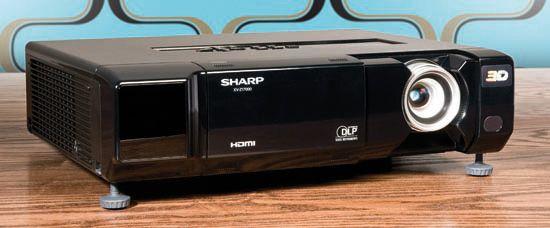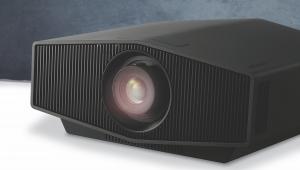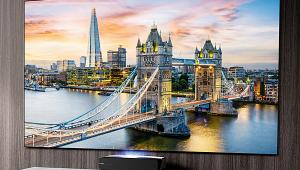Sharp XV-Z17000 review

When asked by Sharp if we wanted to audition its 3D projector, we weren’t about to say no, even though the machine hasn’t yet been confirmed for a UK release. Oddly, Sharp is prevaricating about whether there’s a market for a 3D PJ with a retail price of around £4,000. But AV retailers’ shelves aren’t exactly heaving with such items. There’s only Sony’s VPL-VW90ES (£5,400) and a trio of JVC models, ranging in price from £3,500 to £9,500. And that’s currently it.
DLP-crazyGiven Sharp’s expertise in the LCD field, I was surprised to discover that the full HD XV-Z17000 eschews LCD technology in favour of DLP. The company has combined a single 0.65in DLP chip with a 5x speed six-segment colour wheel. In the past, such an arrangement was noticeably inferior to the three-chip approach; artifacts (including the ‘rainbow effect) could be rather obtrusive on occasions. But the technology has been refined greatly in recent years, so such nasties aren’t as problematic as once they were.
The XV-Z71000 uses active-shutter glasses. Two pairs were supplied with our sample. Shuttering is triggered by the large array of infra-red LEDs bouncing off the screen towards the viewers’ glasses.
The lens, which can be protected by a sliding panel when not in use, is a 1.15x zoom type. Unfortunately, for those with more modest sized viewing rooms, it has a longish throw for a home projector; if you’re after a 3m (diagonal) 16:9 picture, the projector needs to be approximately 4m away from the screen. Zoom and focusing adjustment involves turning sections of the lens barrel. If you’re placing the projector on a flat surface, the front-mounted feet help you align the picture with the screen.
Other setup features, such as vertical/horizontal keystone correction (electronic rather than optical) and projection type (front/rear/desktop/ceiling) are menu-driven. Sharp’s onscreen displays are comprehensive, and can be operated from a control panel set into the top of the PJ and a dinky handset with faintly glow-in-the-dark controls.
Rather more beneficial is the inclusion of a selection button for each input and Sharp has catered for most eventualities here. The upscaling of standard-def sources is handled internally by an IDT ReonVX-210 ‘on a chip’ system.
The menu system gives a selection of six picture presets, all of which can be customised for each input. In addition to contrast, brightness and colour saturation are the ability to adjust red/blue level, colour temperature, iris mode, gamma and colour management. An ‘eco-mode’ reduces the brightness of the picture, but lamp life and black levels benefit. A separate menu covers 3D parameters, such as depth adjust and format selection.
The rainbow is overOut of the box, pictures were surprisingly good, although a basic calibration slightly improved black levels and shadow definition. Contrast range and brightness exceeded my expectations, while rainbow distractions were negligible. Colour reproduction fared better than many single-chip DLP projectors I’ve tried previously. Saturated colours, which feature prominently in animated movies such as Legend of the Guardians: The Owls of Ga’ Hoole were handled with finesse. This particular movie is also awash with detail, all of which the XV-Z17000 took in its stride. Non-CG material gave me no cause for concern either, with realistic textures and skin-tones.
Movement was film-like, as opposed to being unnaturally fluid. I noted some slight judder with vertically-scrolling captions, but that was all. Standard-def TV and DVDs are scaled impressively, according to their limitations.
And so to the third dimension. With the 3D version of Avatar, I immediately noticed that the picture was darkened; Sharp hasn’t compensated for the attenuation of light level caused by the glasses. I recommend a tweak of one of the picture presets specifically for 3D use. There’s a ‘bright boost’ function buried in the menus, but I’m puzzled as to why this isn’t automatically engaged or at least placed in the 3D menu. This aside, the XV-Z17000 gave a good account of itself. Depth and perspective are evident – Avatar’s opening space-station sequence is a great demo here – while crosstalk didn’t detract from my viewing experience. Indeed, a run-through of the opening sequence of Monster House showed no sign of double imaging on the trees in the background, which other 3D displays often throw up. Nor is a tangible 3D effect exclusive to a narrow viewing angle.
Overall, Sharp’s projector is an interesting competitor to JVC’s slightly cheaper X3. Its picture quality is good, and the 3D effect is engrossing and easy on the eye. While the lack of a 12V trigger might annoy installers, the integrated 3D transmitter and smaller build make it more plug ‘n’ play. Should Sharp bring it to Blighty? Yes. Particularly if it can lower the price by a few hundred quid.
HCC VERDICT
Sharp XV-Z17000
Price: £4,000 Approx
Highs: Decent 2D and 3D performance; quiet; free of rainbow effect and little crosstalk
Lows: 4:3 mode unavailable with HDMI-connected source; no optical keystone correction
Performance: 4/5
Design: 3/5
Features: 4/5
Overall: 4/5
Specifications
3D Ready: YES Full-HD: yes 1080p24
Component video: yes one set of inputs
HDMI: yes 2 x v1.4 PC input: yes 1 x 15-pin/D-Sub
12V trigger: no Resolution: 1,920 x 1,080
Brightness (claimed): 1600 ANSI lumens
Contrast ratio (claimed): 40,000:1
Dimensions: 400 (w) x 100(h) x 335(d)mm Weight: 5.8kg
Features: Single-chip DLP with 5x 6-segment colour wheel; image size 40in - 500in; IDT ReonVX-210 video processing; F2.5 - 2.7 lens; manual zoom (1.15) and focus; 6 user-configurable picture presets (standard, natural, dynamic, movie 1, movie 2, game); colour management; noise reduction; multi-standard; digital keystone adjustment
 |
Home Cinema Choice #351 is on sale now, featuring: Samsung S95D flagship OLED TV; Ascendo loudspeakers; Pioneer VSA-LX805 AV receiver; UST projector roundup; 2024’s summer movies; Conan 4K; and more
|























































